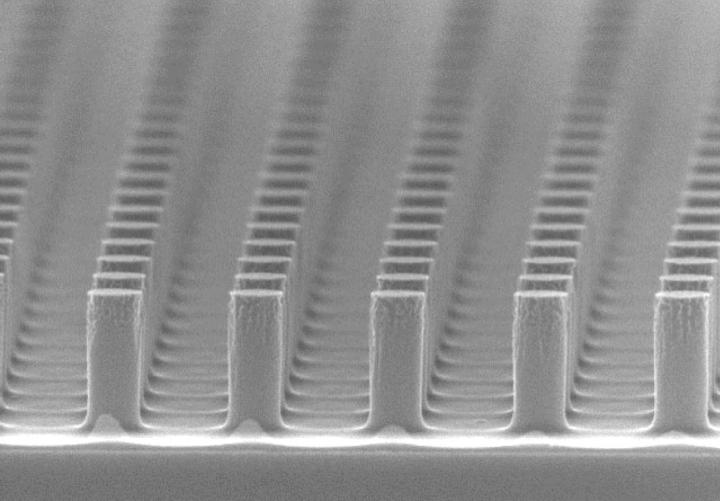A big nano boost for solar cells

A Kyoto University and Osaka Gas silicon device could double the energy conversion rate of solar cells. Each vertical rod measures about 500 nm in height. Credit: Kyoto University/Noda Lab
However, solar cells do not convert all light to power equally, which has inspired a joint industry-academia effort to develop a potentially game-changing solution.
“Current solar cells are not good at converting visible light to electrical power. The best efficiency is only around 20%,” explains Kyoto University's Takashi Asano, who uses optical technologies to improve energy production.
Higher temperatures emit light at shorter wavelengths, which is why the flame of a gas burner will shift from red to blue as the heat increases. The higher heat offers more energy, making short wavelengths an important target in the design of solar cells.
“The problem,” continues Asano, “is that heat dissipates light of all wavelengths, but a solar cell will only work in a narrow range.
“To solve this, we built a new nano-sized semiconductor that narrows the wavelength bandwidth to concentrate the energy.”
Previously, Asano and colleagues of the Susumu Noda lab had taken a different approach. “Our first device worked at high wavelengths, but to narrow output for visible light required a new strategy, which is why we shifted to intrinsic silicon in this current collaboration with Osaka Gas,” says Asano.
To emit visible wavelengths, a temperature of 1000C was needed, but conveniently silicon has a melting temperature of over 1400C. The scientists etched silicon plates to have a large number of identical and equidistantly-spaced rods, the height, radii, and spacing of which was optimized for the target bandwidth.
According to Asano, “the cylinders determined the emissivity,” describing the wavelengths emitted by the heated device.
Using this material, the team has shown in Science Advances that their nanoscale semiconductor raises the energy conversion rate of solar cells to at least 40%.
“Our technology has two important benefits,” adds lab head Noda. “First is energy efficiency: we can convert heat into electricity much more efficiently than before. Secondly is design. We can now create much smaller and more robust transducers, which will be beneficial in a wide range of applications.”
###
The paper “Near-infrared-to-visible highly selective thermal emitters based on an intrinsic semiconductor” appeared 23 December 2016 in Science Advances, with doi: 10.1126/sciadv.1600499
Kyoto University is one of Japan and Asia's premier research institutions, founded in 1897 and responsible for producing numerous Nobel laureates and winners of other prestigious international prizes. A broad curriculum across the arts and sciences at both undergraduate and graduate levels is complemented by numerous research centers, as well as facilities and offices around Japan and the world. For more information please see: http://www.
Media Contact
All latest news from the category: Power and Electrical Engineering
This topic covers issues related to energy generation, conversion, transportation and consumption and how the industry is addressing the challenge of energy efficiency in general.
innovations-report provides in-depth and informative reports and articles on subjects ranging from wind energy, fuel cell technology, solar energy, geothermal energy, petroleum, gas, nuclear engineering, alternative energy and energy efficiency to fusion, hydrogen and superconductor technologies.
Newest articles

Bringing bio-inspired robots to life
Nebraska researcher Eric Markvicka gets NSF CAREER Award to pursue manufacture of novel materials for soft robotics and stretchable electronics. Engineers are increasingly eager to develop robots that mimic the…

Bella moths use poison to attract mates
Scientists are closer to finding out how. Pyrrolizidine alkaloids are as bitter and toxic as they are hard to pronounce. They’re produced by several different types of plants and are…

AI tool creates ‘synthetic’ images of cells
…for enhanced microscopy analysis. Observing individual cells through microscopes can reveal a range of important cell biological phenomena that frequently play a role in human diseases, but the process of…





















